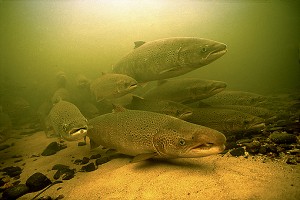By A. O.

The point at which salmon aim to arrive is the place they were born. But make no mistake: it’s not a short distance.
How Do Salmon Find Their Way?
You are mistaken if you think that migration is peculiar to birds. In fact, there are many migratory species on land and in sea. In this article, the adventure of salmon, a migratory fish species, will be examined.
Salmon are born into the world as they hatch from eggs the females of the species lay in the river. They grow and hunt in this place for several weeks after which they start to advance down the river.
During this journey towards the sea, they encounter dams and polluted water and try to avoid dangers such as bigger hunting fishes. Having overcome all these and reached the sea, they spend several years there. Once they mature enough to spawn, they swim back to the freshwater.
The point at which salmon aim to arrive is the place they were born. But make no mistake: it’s not a short distance. The distance that the fish needs to cover to get to the destination may sometimes be 1,500 km (930 miles), which means a demanding journey of months. There are many obstacles that the fish has to overcome during this journey.
The first, and maybe the most important problem that needs to be solved is to find where the river down which the fish swam during its first journey empties into the sea. Based on this, the fish will determine the return route to follow. Amazingly, none of the salmon makes a mistake and they all find the river right first time.
Entering the stream, the salmon starts to steadfastly swim against the current. This time its task is harder because, whereas it could easily pass down waterfalls with the assistance of the current the first time, it has to climb up over them this time. What the salmon in this picture intends by leaping upriver is to reach the place where it was spawned. During this journey, the salmon may need to swim through shallow waters that leave its upper fin above water. These shallow waters are full of birds, bears and many wild predators.
The difficulties that the salmon has to overcome are not limited to these. Recall that it hatched from the egg in a branch of a river, in a quite inner part of the land. In order to reach that point, it has to go the correct way when the river forks into branches. Salmon do not make any mistake in these choices and they always follow the correct stream.
Now suppose that you were born and had grown up in a house in a city. Then one day you left your house, traveled for days and came to a place 1,500 km (930 miles) away from home. Years passed and you desired to return to your place of birth. Do you think that you could possibly remember streets that you passed only once? While no human being could, salmon can and they always find their way faultlessly.
There have been various studies to understand how salmon make this exceptional journey. It has been concluded that salmon find their way by use of “smell”.
Thanks to its ingeniously structured nose, a salmon can pursue a scent in the water to its source just as a hound does. In fact, every current has a distinctive smell. The young salmon records all the smells during its journey and returns home by recalling these smells.
How does this extraordinary thing happen? How could every salmon find its way correctly? Why do all salmon try to return to their place of birth, risking their lives, leaping waterfalls and confronting wild animals? What is more, they do not do all these things for themselves but simply in order to deposit their eggs in these waters.
There is only one answer to these questions: Allah, the All-Knowing, created the salmon and the systems that enable them to find their way. Like all creatures, salmon act by the inspiration they receive from Allah and they manifest the Lord’s excellent creation.
Among the evidence that refutes the theory of evolution is that salmon cover thousands of kilometers and risk their own lives to spawn.
Evolutionists claim that all creatures are always in a struggle with each other and that only the strong survive at the end of this struggle. However, there is a co-operation among living creatures contrary to evolutionists’ assertions. Animals risk their own lives for their offspring. Besides, as you will see in the examples given in the following pages, there are different species that associate with and benefit each other.
The salmon is merely one of the creatures that display self-sacrificing behavior for their offspring. Salmon that migrate and manage to reach the place to spawn, which are very small in number, will die soon after they produce their spawn. Yet they never give up their journey. Such self-sacrificing behavioral patterns cannot by any means be explained by the theory of evolution.
The fact is evident. Allah created salmon and these creatures behave in the way that Allah inspires in them. People who use their intellect take lessons from such behavior of animals. Allah reminds us to do so in a verse:
“There is no creature He does not hold by the forelock…” (Hud 11: 56)
————-
Excerpted with slight editorial modifications from Harun Yahya’s Wonderful Creatures; Part 3.
A. O. is a Turkish writer and author.
 Arabic
Arabic English
English Spanish
Spanish Russian
Russian Romanian
Romanian korean
korean Japanese
Japanese
